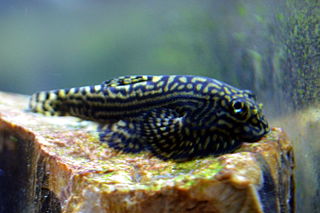
The hillstream loaches or river loaches are a family, the Balitoridae, of small fish from South, Southeast and East Asia. The family includes about 202 species. They are sometimes sold as "lizardfish" or "flossensaugers". Many of the species are popular for aquaria, species in the genus Sewellia are most commonly sold in the aquaria trade. They have a number of similarities with the Cobitidae, their sibling family of "loaches", such as multiple barbels around the mouth. They should not be confused with the loricariids, which look similar but are a family of catfish.

Teleostei, members of which are known as teleosts, is, by far, the largest infraclass in the class Actinopterygii, the ray-finned fishes, and contains 96% of all extant species of fish. Teleosts are arranged into about 40 orders and 448 families. Over 26,000 species have been described. Teleosts range from giant oarfish measuring 7.6 m (25 ft) or more, and ocean sunfish weighing over 2 t, to the minute male anglerfish Photocorynus spiniceps, just 6.2 mm (0.24 in) long. Including not only torpedo-shaped fish built for speed, teleosts can be flattened vertically or horizontally, be elongated cylinders or take specialised shapes as in anglerfish and seahorses.

A riffle is a shallow landform in a flowing channel. Colloquially, it is a shallow place in a river where water flows quickly past rocks. However, in geology a riffle has specific characteristics.

Corydoras kanei is a small species of catfish from the family Callyichthydae endemic to Brazil where it is found in the Negros River basin. It is externally similar to Corydoras atropersonatus, but its spots are denser and unlike the former, it has caudal markings - markings on its tail fins. Breeding can be accomplished by feeding a mixture of live foods and catfish pellets, after which frequent cold water changes can trigger them to spawn. A gravid female will lay around 60 eggs; heavy oxygenation of the water is likely to be more efficacious at saving fry than using methylene blue. Fry grow slowly and reach around 2 cm after 8 months. It is not recommended to add different fish into the fry rearing tank. They do not mind lower temperatures and can be kept with species of fish that are endemic to low-temperature habitats, such as Sewellia lineolata.
Parasewellia is a small genus of hillstream loaches endemic to Vietnam. Described in a single work by Nguyen & Nguyen, the validity of claims, as of 2012, cannot be properly analyzed due to poor descriptions and low quality of illustrations. Due to extremely restricted ranges it is possible that multiple claimed species represent a single one. Maurice Kottelat places them under Sewellia.

Sewellia is a genus of fish in the family Gastromyzontidae. They are commonly called hillstream loaches and are found in Laos and Vietnam. According to Roberts (1998) a possible defining characteristic of the genus Sewellia is their posterior pelvic valve is highly complex and different from other rheophilic loaches, their posterior pelvic valve involves the overlapping of the second to last ventrally exposed rays. Adapted to high velocity streams, Sewellia have depressed body shapes that are laterally expanded, thus increasing their hydrodynamical properties and allowing them to better stay attached to rocks in swift current. Sewellia also have paired fins with a single simple ray and numerous branched rays allowing them to grip rocks in swift current.

Sewellia lineolata, the reticulated hillstream loach, is a species of fish from the provinces of Thua Thien-Hue, Quang Nam, Quang Ngai and Binh Dinh in Vietnam.
Sewellia trakhucensis is a species of fish in the Sewellia genus. The fish is only known in Vietnam.
Sewellia analis is a species of freshwater fish in the family Gastromyzontidae. The fish was discovered in 2005 and is only known in Vietnam.
Sewellia albisuera is a species of fish in the genus Sewellia. The fish is only found in Vietnam and is 6.4 cm (2.5 in) long (SL).
Sewellia speciosa is a species of fish that is part of the family Gastromyzontidae. The fish in both Laos and Vietnam. The fish reaches up to 5.4 centimeters long. (SL)
Sewellia breviventralis is a species of fish belonging in the family Gastromyzontidae. The fish is only known in Vietnam and reaches up to 5.1 cm (2.0 in) long (SL).
Sewellia diardi is a species of fish belonging in the Gastromyzontidae family. The fish is found in Laos, the fish is 7.2 cm (2.8 in) long (SL).
Sewellia elongata is a species of fish in the genus Sewellia. The fish is found in the Se Kong River and is 7.3 cm (2.9 in) long (SL).
Sewellia pterolineata is a species of fish in the genus Sewellia. The fish is found in the Trac Khuc River and is 4.4 cm (1.7 in) long (SL).
Sewellia marmorata is a species in the Sewellia genus. The fish is highly territorial and is only found in Vietnam. The fish maximum length is 6.4 cm (2.5 in) long (SL).
Sewellia patella is a species of fish belonging to the Gastromyzontidae family. The fish is found in Vietnam and the maximum length for the fish is 4.8 cm (1.9 in) long (SL).
Sewellia medius is a species of fish in the family Gastromyzontidae. The fish is only known in Vietnam.




